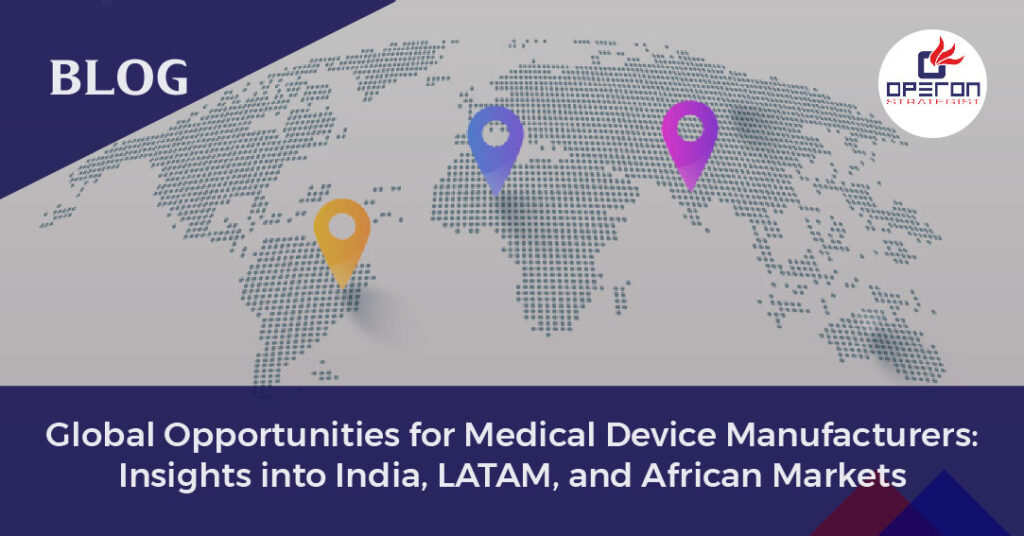Overview - Global Opportunities for Medical Device Manufacturers
In today’s era of healthcare innovation, regions like India, Latin America (LATAM), and Africa offer promising markets for medical device manufacturers. This blog delves into the opportunities and dynamics within these regions, providing valuable insights for manufacturers looking to expand their global presence.
India: A Booming Healthcare Market
India’s booming economy and large population offer lucrative opportunities for medical device manufacturers. The healthcare sector is experiencing substantial growth, fueled by factors like increasing disposable income, rising healthcare awareness, and government initiatives. The demand for advanced healthcare solutions is on the rise, driven by urbanization and modernization of healthcare infrastructure. India’s supportive regulatory environment, including initiatives like the Medical Device Rules, 2017, has simplified approval processes, making entry into the market more accessible for manufacturers.
Looking for a Medical Device Regulatory Consultant?
LATAM: A Diverse Landscape With Untapped Potential
Latin America comprises a diverse set of countries, each with its own unique healthcare challenges and opportunities. While countries like Brazil and Mexico boast relatively developed healthcare systems, others in the region are undergoing rapid transformation, presenting opportunities for medical device manufacturers.
One of the key drivers of the medical device market in LATAM is the increasing prevalence of chronic diseases and the growing aging population. This demographic shift has fueled demand for a wide range of medical devices, including cardiac monitors, insulin pumps, and orthopedic implants.
Despite the potential, navigating the regulatory landscape in LATAM can be challenging, with varying regulations across different countries. However, initiatives like the harmonization of regulatory standards by regional bodies such as the Pan American Health Organization (PAHO) aim to facilitate market access for medical device manufacturers.
Read more about Medical Device Registration in LATAM Countries
African Countries: Addressing Healthcare Disparities
Africa, with its diverse healthcare landscape and growing population, presents both challenges and opportunities for medical device manufacturers. While countries in North Africa boast relatively developed healthcare systems, those in sub-Saharan Africa face significant healthcare disparities and infrastructure challenges.
One of the key opportunities in the African medical device market lies in addressing unmet healthcare needs, particularly in rural and underserved areas. Innovations such as portable diagnostic devices and telemedicine solutions hold promise in improving healthcare access and outcomes in these regions.
However, penetrating the African market requires an understanding of local nuances, including regulatory requirements, distribution channels, and affordability considerations. Collaborating with local partners and leveraging technology for last-mile delivery can be instrumental in overcoming these challenges.
Read more about Medical Device Registration in South Africa
Medical Device Regulatory Authorities for India, LATAM, and African Countries
Each region—India, Latin America (LATAM), and African countries—has its own set of regulatory authorities responsible for overseeing medical devices within their jurisdictions. Here’s an overview of the respective authority bodies:
India:
Central Drugs Standard Control Organization (CDSCO): The CDSCO, under the Directorate General of Health Services, Ministry of Health and Family Welfare, is the primary regulatory authority responsible for regulating medical devices in India. It is tasked with ensuring the safety, efficacy, and quality of medical devices through the implementation of regulatory standards and processes.
Latin America (LATAM):
Regulatory authorities in LATAM vary by country, but some notable ones include:
Brazil:
– Agência Nacional de Vigilância Sanitária (ANVISA): ANVISA is Brazil’s regulatory agency responsible for regulating medical devices. It oversees the registration, importation, distribution, and surveillance of medical devices to ensure their safety and efficacy.
Mexico:
– Comisión Federal para la Protección contra Riesgos Sanitarios (COFEPRIS): COFEPRIS is Mexico’s regulatory agency responsible for regulating health products, including medical devices. It evaluates and authorizes medical devices for importation, distribution, and commercialization in Mexico.
Argentina:
– Administración Nacional de Medicamentos, Alimentos y Tecnología Médica (ANMAT): ANMAT is Argentina’s regulatory authority responsible for regulating medical devices. It oversees the registration, importation, and surveillance of medical devices to ensure their safety and quality.
African Countries:
Regulatory authorities in African countries may vary widely, but some notable ones include:
South Africa:
– South African Health Products Regulatory Authority (SAHPRA): SAHPRA is South Africa’s regulatory authority responsible for regulating health products, including medical devices. It evaluates and approves medical devices for importation, distribution, and use in South Africa.
Nigeria:
– National Agency for Food and Drug Administration and Control (NAFDAC): NAFDAC is Nigeria’s regulatory agency responsible for regulating health products, including medical devices. It oversees the registration, importation, and surveillance of medical devices to ensure their safety and quality.
Kenya:
– Pharmacy and Poisons Board (PPB): PPB is Kenya’s regulatory authority responsible for regulating health products, including medical devices. It evaluates and registers medical devices for importation, distribution, and use in Kenya.
Manufacturers need to familiarize themselves with the specific regulatory requirements and processes established by the relevant authority bodies in each region to ensure compliance and market access for their medical devices. Working with regulatory consultants or legal advisors with expertise in the respective regions can also be beneficial in navigating the regulatory landscape effectively.
Conclusion: Seizing Opportunities in Emerging Markets
As the global demand for healthcare continues to rise, emerging markets like India, LATAM, and various African countries offer fertile ground for medical device manufacturers to expand their footprint. By understanding the unique dynamics and challenges within each region and leveraging innovation and collaboration, manufacturers can unlock significant growth opportunities while contributing to improved healthcare access and outcomes on a global scale.
How Will Operon Strategist Assist?
In the complex landscape of medical device regulatory affairs, having a trusted partner can make all the difference. Enter Operon Strategist, a leading medical device consulting company specializing in guiding medical device manufacturers through the intricacies of regulatory compliance. With a global presence and a wealth of expertise, Operon Strategist is instrumental in helping companies navigate the regulatory waters of diverse markets like India, Latin America (LATAM), and various African countries.
Get Expert Consultation to Easily Market Your Product in India, Africa, and LATAM Countries
- adminhttps://operonstrategist.com/author/admin-2/
- adminhttps://operonstrategist.com/author/admin-2/
- adminhttps://operonstrategist.com/author/admin-2/
- adminhttps://operonstrategist.com/author/admin-2/




